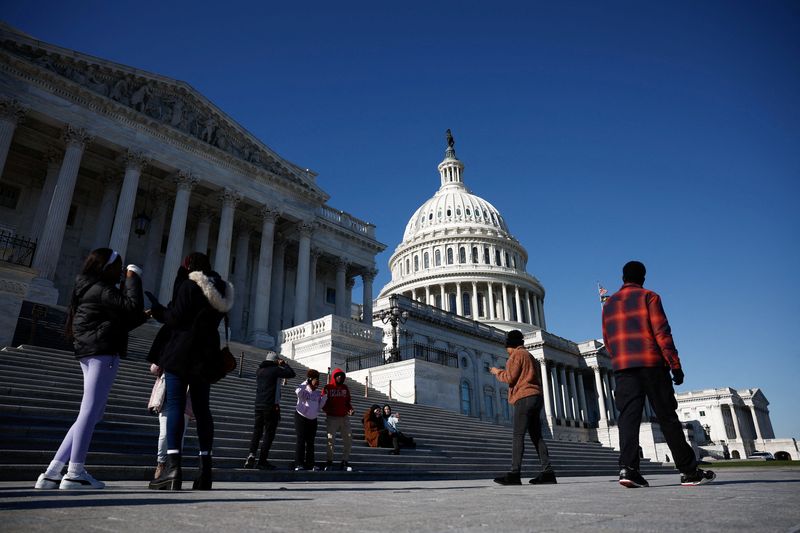By Andy Sullivan
WASHINGTON – Large swaths of the U.S. government could temporarily close at midnight on Friday if Congress does not approve a stopgap spending bill due to pressure from Donald Trump.
The president-elect is also urging lawmakers to approve more government borrowing by addressing the nation’s debt ceiling before he takes office on Jan. 20.
WHY WOULD THE GOVERNMENT SHUT DOWN?
Congress is supposed to allocate funding to 438 government agencies before Oct. 1, the start of the fiscal year. But lawmakers rarely meet this deadline and routinely pass temporary spending bills to keep the government operating while they finish their work. The current temporary spending bill expires on Saturday. Republicans and Democrats have prepared legislation that would push the deadline back to March 14, but Trump has urged his Republicans to vote against it.
If lawmakers don’t work out a deal that can make it through the Republican-controlled House of Representatives and the Democratic-majority Senate and pass it before midnight on Friday, funding for much of the government will lapse.
WHAT IS THE DEBT CEILING?
A debt limit is a cap set by Congress on how much money the U.S. government can borrow. Because the government spends more money than it collects in tax revenue, lawmakers need to periodically tackle the issue — a politically difficult task, as many are reluctant to vote for more debt.
Trump wants Congress to tackle the debt ceiling now so he will not have to deal with it when he is in the White House. One of his first priorities on returning to office will be extending tax cuts passed during his first term. Doing so will add about $4 trillion over the next decade to the U.S. federal government’s current $36 trillion in debt, tax experts say.
Congress set the first debt limit of $45 billion in 1939, and has had to raise that limit 103 times since, as spending has consistently outrun tax revenue. Publicly held debt was 98% of U.S. gross domestic product as of October, compared with 32% in October 2001.
Under a 2023 budget deal, Congress suspended the debt ceiling until Jan. 1, 2025. As a practical matter, the U.S. Treasury will be able to pay its bills for several more months, but Congress will have to address the issue at some point next year.
Failure to act could prevent the Treasury from paying its debts. A U.S. debt default would likely have severe consequences, roiling global financial markets and plunging the country into a recession.
Sometimes Congress raises the debt ceiling quietly, and sometimes lawmakers use the occasion to engage in a noisy debate over fiscal policy before raising the cap at the last possible moment.
Republicans unsuccessfully tried to pair a debt-ceiling hike with spending cuts in 1995 and 1996, leading to two partial government shutdowns. They won significant spending restraints in a 2011 confrontation that pushed the United States to the brink of default and prompted a first-ever downgrade of its top-notch credit rating.
Republicans also won some spending restraints in the 2023 debt-ceiling deal, but many in the party were left frustrated that they did not get more.
WHAT IS THE IMPACT OF A GOVERNMENT SHUTDOWN?
There have been 14 shutdowns since 1981, according to the Congressional Research Service, many lasting only a day or two. The most recent one was also the longest, lasting 35 days between December 2018 and January 2019 due to a dispute between then-President Trump and Congress over border security.
Hundreds of thousands of federal workers would be furloughed without pay and a wide range of services could be disrupted, from financial oversight to trash pickup at national parks.
Other workers deemed essential would remain on the job, though they also would not get paid. Services like mail delivery and tax collection would continue.
Shutdowns that last only a few days have little practical impact, particularly if they occur over a weekend, but the broader economy could suffer if federal employees begin missing paychecks after two weeks.
A shutdown would directly reduce GDP growth by around 0.15 percentage point for each week it lasts, according to Goldman Sachs, but growth would rise by the same amount after the shutdown was resolved.
The 2018-2019 shutdown cost the economy about $3 billion, equal to 0.02% of GDP, according to the Congressional Budget Office.
WHAT FUNCTIONS ARE CONSIDERED ESSENTIAL?
Each department and agency has a contingency plan to determine which employees must keep working without pay.
The 2018-2019 shutdown furloughed roughly 800,000 of the federal government’s 2.2 million employees.
The Department of Homeland Security’s 2022 shutdown plan calls for keeping 227,000 of its 253,000 workers on the job, including border security agents and the Coast Guard.
The Department of Justice said in its 2021 contingency plan that 85% of its 116,000 employees would be considered essential, including prison staff and prosecutors. Criminal litigation would continue, although most civil litigation cases would be paused.
Air travel would remain relatively unimpeded, but in previous shutdowns the Transportation Security Administration has warned that airport-security screeners could call in sick at an increased rate.
It is not clear whether the United States’ 63 national parks would remain open. During a shutdown in 2013, the Obama administration shuttered parks due in part to safety concerns, losing an estimated $500 million. In the 2018-19 shutdown the Trump administration kept them open with public restrooms and information desks closed and waste disposal halted. Some states, such as New York and Utah, paid for their sites to stay open and staffed during the 2018-2019 shutdown.
The Internal Revenue Service has furloughed up to 90% of its staff in the past but all of its employees are considered essential under its current contingency plan.
All military personnel would remain working, but roughly 429,000 civilian Pentagon employees would be furloughed.

